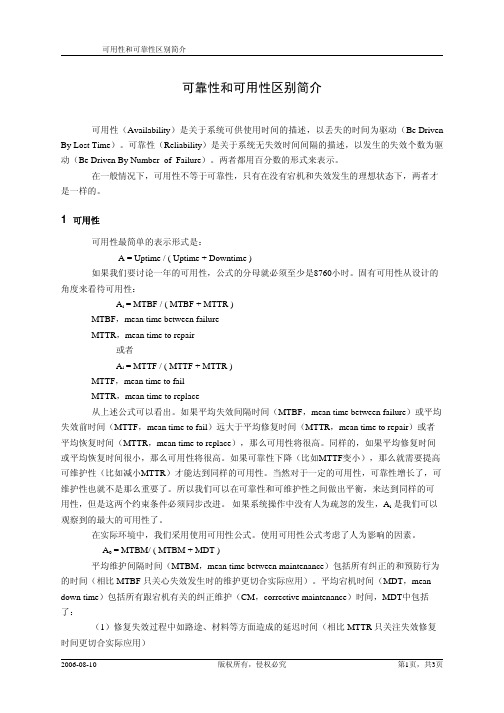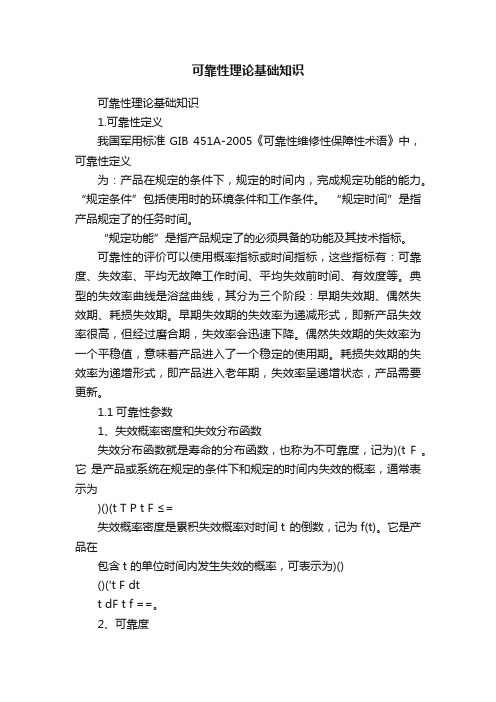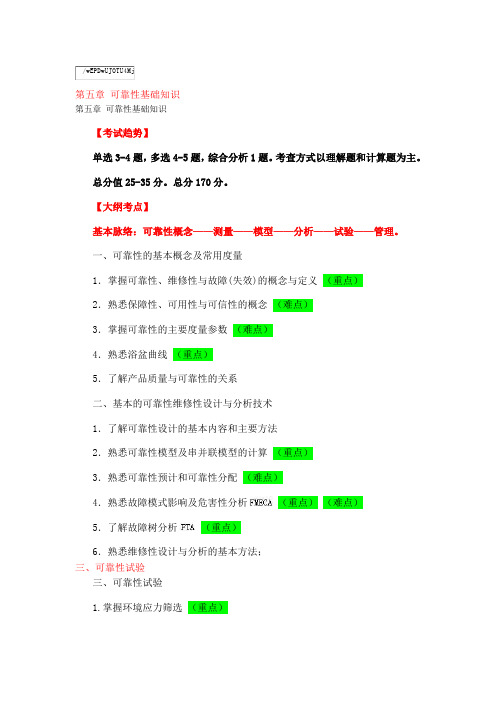可靠性、可用性、失效率基础
可靠性和可用性区别简介

可靠性和可用性区别简介可用性(Availability)是关于系统可供使用时间的描述,以丢失的时间为驱动(Be Driven By Lost Time)。
可靠性(Reliability)是关于系统无失效时间间隔的描述,以发生的失效个数为驱动(Be Driven By Number of Failure)。
两者都用百分数的形式来表示。
在一般情况下,可用性不等于可靠性,只有在没有宕机和失效发生的理想状态下,两者才是一样的。
1可用性可用性最简单的表示形式是:A = Uptime / ( Uptime + Downtime )如果我们要讨论一年的可用性,公式的分母就必须至少是8760小时。
固有可用性从设计的角度来看待可用性:A i = MTBF / ( MTBF + MTTR )MTBF,mean time between failureMTTR,mean time to repair或者A i = MTTF / ( MTTF + MTTR )MTTF,mean time to failMTTR,mean time to replace从上述公式可以看出。
如果平均失效间隔时间(MTBF,mean time between failure)或平均失效前时间(MTTF,mean time to fail)远大于平均修复时间(MTTR,mean time to repair)或者平均恢复时间(MTTR,mean time to replace),那么可用性将很高。
同样的,如果平均修复时间或平均恢复时间很小,那么可用性将很高。
如果可靠性下降(比如MTTF变小),那么就需要提高可维护性(比如减小MTTR)才能达到同样的可用性。
当然对于一定的可用性,可靠性增长了,可维护性也就不是那么重要了。
所以我们可以在可靠性和可维护性之间做出平衡,来达到同样的可用性,但是这两个约束条件必须同步改进。
如果系统操作中没有人为疏忽的发生,A i是我们可以观察到的最大的可用性了。
产品可靠性与可用性分析

产品可靠性与可用性分析产品可靠性与可用性是衡量产品质量的重要指标。
可靠性关注产品运行过程中的故障率、维修时间等指标,而可用性则着眼于产品在实际使用中的效率和易用性。
本文将对产品的可靠性与可用性进行分析,以供相关领域的研究者和从业者参考。
一、可靠性分析可靠性是指产品在规定条件下,在一定时间内完成规定功能的能力。
在对产品可靠性进行分析时,可以采用故障率、失效率、平均故障间隔时间等指标来评估产品的可靠性水平。
1. 故障率分析故障率是指在单位时间内产品出现故障的概率。
一般来说,故障率越低,产品的可靠性就越高。
为了准确评估产品的故障率,可以通过大量的历史数据和实验数据进行统计分析。
通过分析故障率的变化趋势,可以预测产品在不同时间段内的可靠性变化。
2. 失效率分析失效率是指在产品正常使用期内,单位时间内产品失效的概率。
失效率与产品的可靠性密切相关,失效率越低,产品的可靠性就越高。
失效率分析可以通过对产品失效原因的统计和分析,找出影响产品可靠性的主要因素,并采取相应的措施进行改进。
3. 平均故障间隔时间分析平均故障间隔时间是指在产品正常使用情况下,连续两次故障之间的时间间隔的平均值。
通过分析平均故障间隔时间,可以评估产品的整体可靠性水平。
较长的平均故障间隔时间表明产品故障频率较低,可靠性较高。
二、可用性分析可用性是指产品在实际使用中能够方便、高效地完成用户需求的程度。
在产品的可用性分析中,可以考虑用户体验、系统响应时间、错误处理机制等因素来评估产品的可用性。
1. 用户体验分析用户体验是衡量产品可用性的重要指标之一。
产品应该能够提供简洁、直观、符合用户习惯的操作界面,使用户能够快速上手并高效地完成任务。
通过用户调研、用户测试等方法,可以了解用户对产品的满意度和改进建议,从而提升产品的可用性。
2. 系统响应时间分析系统响应时间是指用户发出请求后,系统给出反馈的时间间隔。
优秀的产品应该能够在较短的时间内响应用户的请求,以提高用户的工作效率和满意度。
可靠性基础知识

可靠性基础知识研究可靠性的意义对于产品来说, 可靠性问题和人身安全, 经济效益密切相关 . 因此, 研究产品的可靠性问题, 显得十分重要 . 非常迫切 .1) 提高产品可靠性, 可以防止故障和事故障的发生, 尤其是避免灾难性的事故发生 .86 年1 月28 日, 美航天飞机” 挑战者号” 由于 1 个密封圈失效, 起飞76S 后爆炸, 其中7 名宇航员丧生, 造成12 亿美元的经济损失;92 年我国发射” 澳星号” 时由于一个小小零件的故障, 发射失败, 造成了巨大的经济损失和政治影响到 .2) 提高产品的可靠性, 能使产品总的费用降低 . 提高产品的可靠性, 首先要增加费用, 如选用好的元器件, 研制部分冗余功能的电路及进行可靠性设计、分析、实验,这些都需要经费。
然而,产品可靠性的提高使得维修费及停机检查损失费大大减小,使总费用降低。
3 )提高产品的可靠性,可以减少停机时间,提高产品可用率,一台设备可顶几台用,可以发挥几倍的效益。
美国GE 公司经过分析认为,对于发电、冶金、矿山、运输等连续作业的设备,即使可靠性提高1% ,成本提高10% 也是合算的。
4 )对于公司来讲,提高产品的可靠性,可以改善公司信誉,增强竞争力,扩大市场份额,从而提高经济效益。
一般所说的“ 可靠性” 指的是“ 可信赖的” 或“ 可信任的” 。
我们说一个人是可靠的,就是说这个人是说得到做得到的人,而一个不可靠的人是一个不一定能说得到做得到的人,是否能做到要取决于这个人的意志、才能和机会。
同样,一台仪器设备,当人们要求它工作时,它就能工作,则说它是可靠的;而当人们要求它工作时,它有时工作,有时不工作,则称它是不可靠的。
根据国家标准的规定,产品的可靠性是指:产品在规定的条件下、在规定的时间内完成规定的功能的能力。
我国的可靠性工作起步较晚,20 世纪70 年代才开始在电子工业和航空工业中初步形成可靠性研究体系,并将其应用于军工产品。
可靠性理论基础知识

可靠性理论基础知识可靠性理论基础知识1.可靠性定义我国军用标准GIB 451A-2005《可靠性维修性保障性术语》中,可靠性定义为:产品在规定的条件下,规定的时间内,完成规定功能的能力。
“规定条件”包括使用时的环境条件和工作条件。
“规定时间”是指产品规定了的任务时间。
“规定功能”是指产品规定了的必须具备的功能及其技术指标。
可靠性的评价可以使用概率指标或时间指标,这些指标有:可靠度、失效率、平均无故障工作时间、平均失效前时间、有效度等。
典型的失效率曲线是浴盆曲线,其分为三个阶段:早期失效期、偶然失效期、耗损失效期。
早期失效期的失效率为递减形式,即新产品失效率很高,但经过磨合期,失效率会迅速下降。
偶然失效期的失效率为一个平稳值,意味着产品进入了一个稳定的使用期。
耗损失效期的失效率为递增形式,即产品进入老年期,失效率呈递增状态,产品需要更新。
1.1可靠性参数1、失效概率密度和失效分布函数失效分布函数就是寿命的分布函数,也称为不可靠度,记为)(t F 。
它是产品或系统在规定的条件下和规定的时间内失效的概率,通常表示为)()(t T P t F ≤=失效概率密度是累积失效概率对时间t 的倒数,记为f(t)。
它是产品在包含t 的单位时间内发生失效的概率,可表示为)()()('t F dtt dF t f ==。
2、可靠度可靠度是指产品或系统在规定的条件下,规定的时间内,完成规定功能的概率。
可靠度是时间的函数,可靠度是可靠性的定量指标。
可靠度是时间的函数,记为)(t R 。
通常表示为?∞=-=>=t dt t f t F t T P t R )()(1)()(式中t 为规定的时间,T 表示产品寿命。
3、失效率已工作到时刻t 的产品,在时刻t 后单位时间内发生失效的概率成为该产品时刻t 的失效率函数,简称失效率,记为)(t λ。
)(1)()()()()()(''t F t F t R t F t R t f t -===λ。
信息安全工程师考点—计算机设备安全

希赛网软考频道小编为大家整理了信息安全工程师考点—计算机设备安全,希望对在备考信息安全工程师的考生有所帮助。
考点1、计算机设备安全【考法分析】本考点主要是对计算机设备安全的考查。
【要点分析】1.一般认为,计算机安全的定义,要包括计算机试题及其信息的完整性,机密性,抗否认性,可用性,可审计性,可靠性等几个关键因数;机密性:保证信息部被非授权访问;完整性:维护信息和试题的人为或非人为的非授权篡改;抗否认性:指保障用户无法再时候否认曾经对信息进行的生成,签发,接受等行为;可用性:授权用户根据需要可以随时访问所需信息;可审计性:保证计算机信息系统所处理的信息的完整性,准确性和可靠性,防止有意或无意地出现错误,乃至防止和发现计算机犯罪案件,除了采用其他安全措施之外,利用对计算机信息系统的审计的方法。
利用审计跟踪的工具,可以记录用户的活动;审计跟踪可以监控和扑捉各种安全事件;审计跟踪的另一个主要功能是保存,维护和管理审计日志。
可靠性:指计算机在规定的条件下和给定的时间内完成预定功能的概率;所谓“失效率”是指计算机在某一瞬间失效元件数与元件总数的比率。
影响计算机可靠性的因数有内因和外因两个方面:内因:机器本身的因数外因:指环境条件对系统可靠性,稳定性和维护水平的影响一般认为,在系统的可靠性工程中,元器件是基础,设计是关键,环境是保证。
除了保证系统的正常工作条件及正确使用和维护外,还要采取容错技术和故障诊断技术。
容错技术:指用增加冗余资源的方法来掩盖故障造成的影响;故障诊断技术:通过检测和排除系统元器件或线路故障。
2.由于计算机系统本身的脆弱性以及硬件和软件的开放性,加之缺乏完善的安全措施,容易给犯罪分子以可乘之机。
3.计算机系统安全涉及到许多学科,因此它是一个综合性很强的问题。
要想解决和计算机系统的安全,就必须首先从计算机的系统结构和基础出发,从计算机硬件环境出发,找到一条合理地解决问题的道路。
4.计算机系统安全是指:为了保证计算机信息系统安全可靠运行,确保计算机信息系统在对信息进行采集,处理,传输,存储过程中,不致收到人为(包括未授权使用计算机资源的人)或自然因数的危害,而使信息丢失,泄露或破坏,对计算机设备,设施(包括机房建筑,供电,空调等),环境人员等采取适当的安全措施。
1.7系统可靠性基础

1.7系统可靠性基础考什么?一、基本概念(1)系统的可靠性:从它开始运行(t=0)到某时刻t这段时间内能正常运行的概率,用R(t)表示。
(2)失效率:单位时间内失效的元件数与元件总数的比例,通常用λ表示。
当λ为常数时,可靠性与失效率的关系为:R(t)=e-λt。
(3)平均无故障时间(MTBF):两次故障之间系统能正常工作的时间的平均值。
它与失效率的关系为:MTBF=1/λ。
(4)平均失效前时间(MTTF):从故障发生到机器修复平均所需要的时间。
而通常用平均修复时间(MTTR)来表示计算机的可维修性,即计算机的维修效率。
(5)可用性:计算机的使用效率,它以系统在执行任务的任意时刻能正常工作的概率A来表示:A=MTBF/(MTBF+MTTF)。
二、系统可靠性模型(1)串联系统:假设一个系统由N个子系统组成,当且仅当所有的子系统都能正常工作时,系统才能正常工作,如图1-6(a)所示。
(2)并联系统:假如一个系统由N个子系统组成,只要有一个子系统正常工作,系统就能正常工作,如图1-6(b)所示。
(3)N模冗余系统:由N个(N=2n+1)相同的逻辑线路和一个表决器组成,只要有n+1个或n+1个以上能正常工作,系统就能正常工作,输出正确的结果,如图1-6(c)所示。
各系统的可靠性和失效率的计算公式如表1-3所示。
表1-3 系统的可靠性和失效率的计算公式注:是从N个元素中选i个元素的组合数,值为当N=3时,怎么考【试题1-30】 2007年11月真题1若某计算机系统由两个部件串联构成,其中一个部件的失效率为7×10-6/小时。
若不考虑其他因素的影响,并要求计算机系统的平均故障间隔时间为105小时,则另一个部件的失效率应为(1) /小时。
解析:平均无故障时间与失效率的关系为:MTBF=1/λ,则计算机系统的总失效率为系统平均故障间隔时间的倒数,即小时。
对于串联系统,计算机系统的总失效率为各部件失效率的和。
第五章 可靠性基础知识(1)可靠性的基本概念及常用度量

第五章可靠性基础知识第五章可靠性基础知识【考试趋势】单选3-4题,多选4-5题,综合分析1题。
考查方式以理解题和计算题为主。
总分值25-35分。
总分170分。
【大纲考点】基本脉络:可靠性概念——测量——模型——分析——试验——管理。
一、可靠性的基本概念及常用度量1.掌握可靠性、维修性与故障(失效)的概念与定义(重点)2.熟悉保障性、可用性与可信性的概念(难点)3.掌握可靠性的主要度量参数(难点)4.熟悉浴盆曲线(重点)5.了解产品质量与可靠性的关系二、基本的可靠性维修性设计与分析技术1.了解可靠性设计的基本内容和主要方法2.熟悉可靠性模型及串并联模型的计算(重点)3.熟悉可靠性预计和可靠性分配(难点)4.熟悉故障模式影响及危害性分析(重点)(难点)5.了解故障树分析(重点)6.熟悉维修性设计与分析的基本方法;三、可靠性试验三、可靠性试验1.掌握环境应力筛选(重点)2.了解可靠增长试验和加速寿命试验(重点)3.手续可靠性测定试验(难点)4.了解可靠性鉴定试验四、可信性管理1.掌握可信性管理基本原则与可信性管理方法(难点)2.了解故障报告分析及纠正措施系统(重点)3.了解可信性评审作用和方法第一节可靠性的基本概念及常用度量【考点解读】第一节可靠性的基本概念及常用度量学习目标要求:1、掌握可靠性、维修性与故障的概念与定义2、熟悉保障性、可用性及可信性的概念3、掌握可靠性的主要度量参数4、了解浴盆曲线5、了解产品质量与可靠性关系基本脉络是:可靠性——不可靠(故障)——可靠度——可靠度函数——常用指标——模型——地位意义(与质量的关系)典型考题典型考题:单选题22、下述设计方法中不属于可靠性设计的方法是()。
a、使用合格的部件b、使用连续设计c、故障模式影响分析d、降额设计23、产品使用寿命与()有关。
a、早期故障率b、规定故障率c、耗损故障率d、产品保修率一、故障(失效)及其分类一、故障(失效)及其分类1、故障定义:产品或产品的一部分不能或将不能完成预定功能的事件或状态称为故障。
可靠性计算公式大全

2. 故障率(Fault rate):故障率是指系统发生故障的频率,与失效率类似。故障率的计算公式如下:
R=(累计故障数)/(总的运行时间)
3.平均无故障时间(MTBF):平均无故障时间是指在正常使用条件下系统或者组件连续运行的平均时间,MTBF越大表示系统越可靠。MTBF的计算公式如下:
可靠性计算公式大全
可靠性是指系统、产品或者服务在一定时间范围内能够正常工作,不发生故障或者故障发生的概率较低的能力。在工程领域,可靠性是非常重要的指标之一,可以通过可靠性计算公式来评估和预测系统的可靠性。下面是一些常用的可靠性计算公式:
1. 失效率(Failure Rate):失效率是指在单位时间内系统或者组件发生故障的概率,通常用λ表示。失效率的计算公式如下:
F=(故障次数)/(总的运行时间或者使用次数)
7. 出故期望数(Expected Number of Failures):出故期望数是指在系统的寿命中预期会发生的故障数。
E=λ*T
其中,λ为失效率,T为系统的寿命。
8. 生存概率(Survival Probability):生存概率是指在一定时间内系统或者组件正常工作的概率。生存概率的计算公式如下:
P=e^(-λt)
其中,e为自然对数的底数,λ为失效率,t为时间。
以上是一些常用的可靠性计算公式,不同的系统和产品可能会有不同的计算公式适用,根据具体情况选择适合的公式进行计算,以评估和预测系统的可靠性。
5.故障间隔时间(MTTF):故障间隔时间是指系统连续工作的平均时间,即从一次故障修复完毕到下一次故障发生之间的时间间隔。MTTF的计算公式如下:
MTTF=(总的运行时间)/(故障次数)
- 1、下载文档前请自行甄别文档内容的完整性,平台不提供额外的编辑、内容补充、找答案等附加服务。
- 2、"仅部分预览"的文档,不可在线预览部分如存在完整性等问题,可反馈申请退款(可完整预览的文档不适用该条件!)。
- 3、如文档侵犯您的权益,请联系客服反馈,我们会尽快为您处理(人工客服工作时间:9:00-18:30)。
E. Topuz
Dogu~ University, Electronics and Communications Eng. Dept. Zeamet Sokak 21, Acibadern - Kadikoy, 34722 Istanbul, Turkey E-mail: etopuz@.tr
A3 = 0.9979 A4 = 0.9993
231
2.
BB4 6 months 3 hours
IEEE Antennas and Propagation Magazine, Vol. 51, No.5, October 2009
parameters . On the other hand, if a subsystem containing two identical modules is considered fully operational when either one of its modules is operational, then one of them is clearly redundant. Such subsystems may be modeled as a parallel connection of two (or more) BBs. A topological model for reliability analysis of David's smart home is depicted in Figure I . The basic system consists of a cascade of BB2, BB3, BB4, and the ten sensors, S\ through SIO' which make up BB I . Redundant BBs, which may be added to the basic system in order to achieve the required overall availability performance, are indicated with a bar on top, and connected in parallel with their twins. The objective is the calculation of the availability performance of the entire system, based on the life distributions of the BBs (and their redundant twins) from which it is composed.
Table 1. The availability performance of the four building blocks. MTBF MTTR Cost Unit Availability Al = 0.986 1.0 BB1 0.1 years 12 hours Az = 0.9986 2.0 1 day BB2 2 years BB3 4 years 3 days 1.5 0.5
4.
5.
The first step in reliability analysis is to break up the system at hand into simpler modules and subsystems. The appropriate fragmentation level is determined either by the availability of vendor-provided reliability data at this level, or by the time or cost advantages of performing reliability tests on chosen subsystems, rather then on the entire system. In the present case, we are given that reliability calculations for David's smart house project involve four subsystems or "building blocks" (BB). The second step is to prepare a reliability model of the system. At this stage, we decide the parallel and serial connectivity of the system. We note that when a system consisting of a number of building blocks is considered as not operational in case of the failure of anyone BB, then it may be modeled as a series chain of BBs, each characterized by its own reliability performance
Hale Waihona Puke 3.ABB2 houses the man-machine interface and computational intelligence. The RF subsystem, including transponder and antenna, make up BB3, and BB4 is responsible for providing power to all other BBs. The smart house system will be considered to be unavailable during periods of time wherein anyone of the building blocks does not function as designed. The method to be used for decreasing downtime is to use redundancy. In case a replica of any BB needs to be purchased for this purpose, this redundant BB will be integrated into the system as a hot-standby unit.
1. Introduction
n item or system is specified, designed, and procured to meet a functional requirement, and it is important that it satisfies this requirement. It is also desirable that the item or system should be predictably available. This depends upon its reliability and availability. Weare tempted to take for granted that everything around us will function as designed on a continuous basis. Except for rare events to the contrary, this is precisely what we experience in our daily lives. Rare though it may be, the occasional malfunctioning of a device may cause us varying degrees of inconvenience, say, while brewing coffee, driving to a meeting, or needing to sniff some oxygen from a scuba tank in an underwater cave. We thus need to work out efficient ways of minimizing the risk of possible damage that may result from device or system failures in a given application. This can be achieved via reliability engineering, which provides a rigorous framework for determining appropriate system design, production, test and evaluation procedures, and operation and maintenance policies. In what follows, we will present a grossly simplified and condensed review of the basics of reliability, availability, and maintainability calculations. The reader is referred to the numerous excellent texts on reliability engineering for indepth analysis of the subject [1-3]. Before discussing the rules of the game, let us recall the quiz problem: David plans to convert his house into a "smart" house. He would like us to calculate the yearly downtime of the built-in intelligence, and the price he would have to pay for reducing this period. David provided the following inputs: 1. For reliability calculations, the smart house can be broken down into four subsystems or building blocks (BB). For each BB, we are given its relative cost and the reliability parameters mean time between failure (MTBF) and mean time to repair (MTTR) (see Table 1). BB1 consists of ten sensors with a dedicated communications infrastructure. All sensors and related communications in BB1 have identical failure and repair rates, and BB1 will be considered unavailable in the case of a malfunction of a single sensor.
